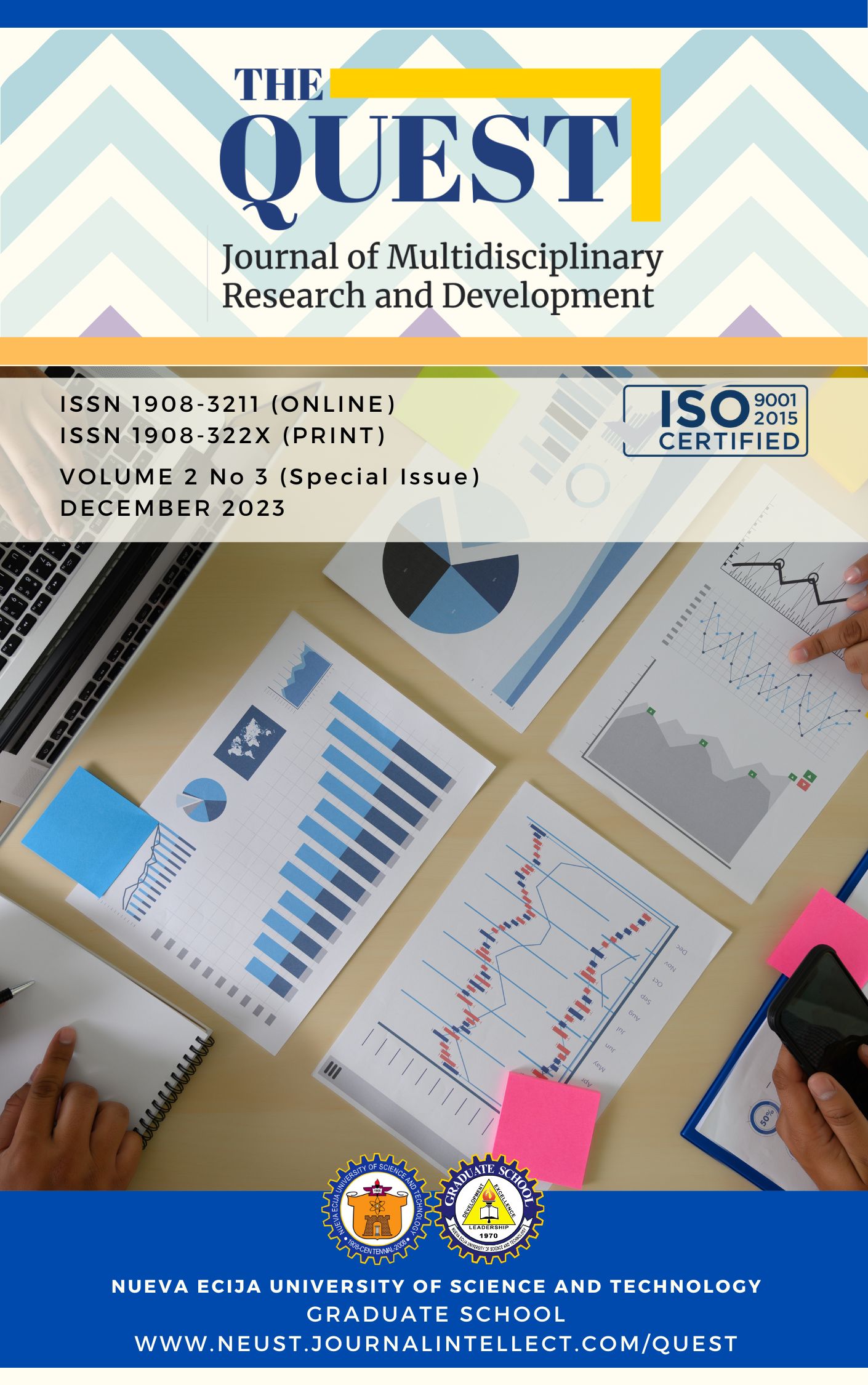Rural Healthcare Service Delivery in Pantabangan, Nueva Ecija, Philippines: Basis for Rural Health Program and Service Planning

Published 12/30/2023
Keywords
- Healthcare
How to Cite
Copyright (c) 2023 The QUEST: Journal of Multidisciplinary Research and Development

This work is licensed under a Creative Commons Attribution-NonCommercial 4.0 International License.
Abstract
The significance of health cannot be overemphasized. The maintenance of optimal health is of paramount importance, necessitating the cultivation of holistic well-being that encompasses not only physical health but also mental and emotional well-being. The state of an individual's health is a determining factor in their overall functionality. The study evaluates the healthcare service delivery of rural health center in Barangay Marikit, Pantabangan, Nueva Ecija, Philippines and the challenges they encountered. The study utilized a descriptive approach, involving the distribution of questionnaires to individuals residing in the barangay. The respondents were selected based on their firsthand experience with the provision of healthcare services. Based on the findings, there are several potential measures that may be taken to ensure that government investment is in line with the present and future requirements of the population and health system. Additionally, efforts can be made to enhance the capabilities of health workers in emergency and disaster management. There is a need to ensure that health care service personnel possess the necessary skills and receive proper training and support to effectively convey information to patients and their families with clarity and compassion.
References
- Aziz, H. A. 2016. A review of the role of public health informatics in healthcare. Journal of Taibah University Medical Science, 78-81.
- Bustamante, JY., Ramos, VB., Jacoba, FP., La Penia, RF. 2022. Resiliency Amidst Vulnerability: A Story of the Indigenous Cultural Communities-Indigenous Peoples' Experiences in Mitigating the Impact of Pandemic in the Philippines. International Journal of Ecosystem and Ecology Science (IJEES) Volume 12,Issue 4
- Collado, Z., 2022. Challenges in public health facilities and services: evidence from a geographically isolated and disadvantaged area in the Philippines.
- Frenk, J., Chen, L. Bhutta, ZA., Cohen, J., Crisp, N., Evans, T., Fineberg, H., Garcia, P., Ke, Y., Kelley, P., et al. 2010. Health professionals for a new century: transforming education to strengthen health systems in an interdependent world. Lancet. 376:1923–1958.
- Hassan, N., Rashid, H., & Das, a. R. 2017. Smart Health Management System for Rural Area of Bangladesh Utilizing Smartphone and NID. 1st International Conference on Business & Management, 191-194.
- Kim, J., Lee, Y., Lim, S., Kim, J. H., Lee, B., & Jae-Ho. 2017. What Clinical Information Is Valuable to Doctors Using Mobile Electronic Medical Records and When? JOURNAL OF MEDICAL INTERNET RESEARCH, 1-13.
- Kunz, E., 2022. Healthcare Access in Rural Communities Overview - Rural Health Information Hub
- Larkins, S., Preston, R., Matte, M., Lindemann, IC., Samson, R., Tandinco, FD., Buso, D., Ross, SJ., Palsdottir, B., Neusy, AJ., et al. 2013. Measuring social accountability in health professional education: development and international pilot testing of an evaluation framework. Med Teach. 35:32–45
- Mantaring, AV., Espinoza, MAP and Gabriel, AG. 2019. ‘Complaint Management in the Public Sector Organization in the Philippines,’ Public Policy and Administration Research, vol. 9/2: 1-26.
- Palanisam, V., & Thirunavukarasu, R. 2017. Implications of big data analytics in developing healthcare frameworks: A review. Journal of King Saud University-Computer and Information Sciences, 1-11.
- Patricia M., Marlene M., Sue O., Brad G., (Eds.) 2007. Identifying rural health care needs using community conversations. The Journal of Rural Health 23 (1), 92-96.
- Rosewell, A., Makita, L., Muscatello, D., John, L. N., Bieb, S., & Hutton, R. 2017. Health information system strengthening and malaria elimination in Papua New Guinea. Malaria Journal, 16-278. 5.
- Sandra M., Corey W., Nakeitra B., Erica T., Mauda M. 2020. Peer reviewed: The role of public health in COVID-19 emergency response efforts from rural health perspective. Preventing Chronic Disease
- Santiago, JD., Vasallo, RM., Dionisio, MR., Binuya, FR., Casimiro, RR., Ramos, VB. 2021. Assessing the Benefits of a One-Stop Medical and Financial Support Program: From the Standpoint of Patients of Eduardo L. Joson Memorial Hospital in the Philippines. Journal of Public Administration and Governance, Vol. II, No. 4.
- Sheikhali, S. A., Abdallat, M., Mabdalla, S., Al Qaseera, B., Khorma, R., Malik, M., et al. 2016. Design and implementation of a national public health surveillance system in Jordan. International Journal of Medical Informatics, 58–61.
- Sidek, Y. H., & Martins, J. T. 2017. Perceived critical success factors of electronic health record system implementation in a dental clinic context: An organizational management perspective. International Journal of Medical Informatics, 88-100.
- Villanueva, E., 2021. Nueva Ecija Provincial Health Office: Health Management System with Web-Based and Mobile Application.
- World Health Organization (WHO). 2010. Increasing access to health workers in remote and rural areas through improved retention: global policy recommendations. Geneva
